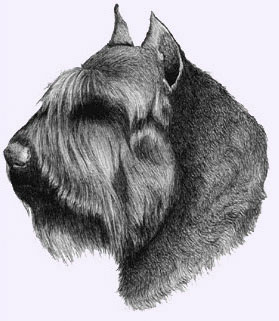
Centauri Story
Jim Engel
In the beginning, on the Flemish plane adjacent to the North Sea, there were cattlemen with their rustic herding and guardian dogs which had evolved in terms of structure and character according to the requirements of their agrarian way of life. Early in the twentieth century the founders of the formal breed gathered such dogs together in order to preserve this age old heritage, and those who breed these dogs today are merely the guardians of this heritage, obligated to preserve and protect it. Thus in this sense no one founds a breeding line or can take full credit for what comes from his kennel, for ultimately we must acknowledge those age old cattlemen and their dogs, whose names we do not know, and the generations of breeders who have been faithful onto the heritage and passed on to us not only the foundation, but the obligation. Thus the most credit must be allocated to these unnamed progenitors and those with names such as Moermon, Scharlaken, Gryson, Chastel, Bowles, Houttuin and Krijnse-Locker.
Gambit
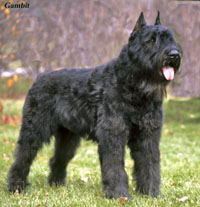
Clk to enlarge
We came to dog breeding relatively later in life, in our thirties. From grade school on my aspiration was to become an engineer. My university major was electrical engineering from day one, and I did not ever think of anything else — it carried right on through graduate school and into industry. It would seem that I was methodical and driven, bordering on compulsive.
But going to the dogs was an entirely different story. There were no childhood canine ambitions, no awareness at all – dogs just came into life from time to time, were around and then they were not. German Shepherds and Dobermans seemed vaguely appealing, sort of as accoutrements for a macho man persona, but that was about the extent of it. Like others I had been enamored by Lad the Collie in the Albert Payson Terhune books, but it was passing. I read a lot of books.
As with so many roads less traveled, our canine journey evolved more or less by chance, from casual companion ownership and hobby level training into breeding, more competitive training, advocacy in the canine press and participation in national and international canine affairs. By a twist of fate, really a whole series of interventions of fate, with no foresight or plan at all, things just fell into place; no plan could have been better laid out than what happened by pure random chance, by happenstance. Although we had no idea at the time, the Bouvier des Flandres in the latter 1970s was a breed in ascendance worldwide, and the American Schutzhund movement was gathering momentum in lock step with our evolution from pet owners to hobby trainers to being fully engaged. When the time came to speak out the working canine press was emerging and looking for strong talent, and when fortunes ebbed in the mid 90's the Internet emerged from nowhere, almost like it was created with me in mind. But this is getting ahead of the story.
Edmee Bowles
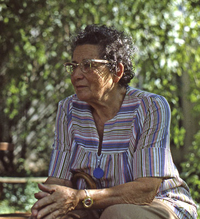
Clk to enlarge
By the middle 1970s we were in our 30s and a home in the far suburbs of Chicago had opened up the opportunity for dog ownership, and a Collie was soon going off to obedience class with my wife Kathy. But somehow he did not quite live up to the Albert Payson Terhune mythology, was more or less dull, flat in personality and prone to just wander off. He soon found a proverbial new home in the country, a real one rather than a final trip to the dog disposal place.
As we moved on dogs became more serious, acquired with a bit of an eye to suitability for training rather than just popular image and mythology. We began looking into German Shepherds and after more research than with the Collie acquired a pup from a local breeder. Nominally the dog was for Kathy to train, and tracking was the first order of business. Being the closest thing we had to a nefarious pseudo villain, I was soon out in the fields taking increasingly long and devious paths to a hiding place, to be sought out by the new dog, called Buck, who had proven to be smart and driven. Soon we had the AKC tracking certificate; and in the process Buck had somehow chosen to be my dog. So off we went to obedience class. I had never trained a dog – or even had a dog of my own – so this dog initiated adoption was another quirk of fate, an unforeseen fork in the road. Kathy consoled herself by going off to buy the Bouvier puppy she had in mind in the first place.
Buck turned out to be a remarkable obedience candidate; as rank novices we became quite successful: the first time entering any sort of canine competition we took home an impressive trophy for third place over all in a huge German Shepherd specific obedience trial, and went on to fill up a small shelf of trophies on the way to the AKC Companion Dog certificate. Although gratified I was also a bit perplexed, had no real idea of how this had come to pass. How could such an inexperienced trainer just walk in and do so well? Eventually we came to understand that breeding does matter; in seeking to comprehend what was happening we began to think in terms of background and pedigree and found that the sire was of the imported German working lines of Paul Hombach and the mother was of the better sort of American breeding.
In that era the German Shepherd obedience people were oblivious to the Euro lines, mostly taking pet quality discards from American show stock and attempting to train it. The fact that they tended to congregate in Shepherd only training clubs was perhaps a factor in obscuring the fact that these dogs were really not very good by any objective standard, lethargic and generally unresponsive. It took a while to sink in; the fact of the matter was that we were training a dog with a relatively strong working background and competing with dogs of extremely limited inherent potential; I was successful primarily because most of the others were out there with a hand tied behind their back.
That our training club was strongly under the influence the Bill Koehler methodology also played a role, to this day I believe that although competition training, as opposed to practical, requires a more overtly motivational approach Koehler advocated fundamentally sound foundation training. In any event, it was a good fit for our circumstances. Shortly thereafter the dog seemed listless on our evening run, so just to be safe Kathy took him to the vet the next morning; by midafternoon he was dead. It was Parvovirus, something so new we had never heard of it. I was deeply despondent, but through this experience found myself on a new road, for this dog had changed my life – small matters do indeed sometimes have unforeseen consequences.
Schutzhund was a new thing in that era: foreign, mysterious and more than a bit suspect. Establishment dog people were appalled that anybody would actually encourage a dog to bite; going off to Schutzhund was akin to a good Catholic going off in the middle of the night to celebrate a Black Mass. Naturally we were soon on the way to see all about it, Kathy with her young Bouvier and I with my young German Shepherd from American show lines – I still did not quite get it. After all, as was the mantra of the show breeders, if you were going to put all that work into training a German Shepherd it was foolish to waste time on anything less than the best, and surely all of those champions must be indicative of true quality. Although there was a disquieting glimmer of understanding I still had much to learn, had bought the wrong dog for all of the wrong reasons.
In retrospect the new dog was pretty much what one would expect, the other trainers at the Schutzhund club had these inexplicable pained looks on their face as the dog sort of ambled over to you on the recall, and was willing to bite a little bit if that would make you happy, but was obviously ready to go home early on. This dog was soon gone, and I was on to Bouviers and never looked back. Nevertheless, I have come to have enormous respect for the German Shepherd and his heritage, and am deeply troubled by the road the show establishment went down, particularly the SV in Germany. The experience left me with enormous respect the old style hard core German Shepherd dogs, trainers and breeders; in many ways they were the pioneers and innovators.
Vacher's Alpha Centauri
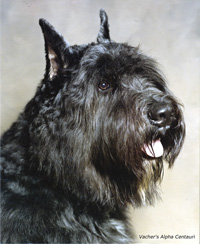
Clk to enlarge
Our first Bouvier was purchased from a local breeder, we were still more or less companion level people without the expectation of conformation shows, breeding or competitive training, looking for something a little different and intrigued by a photo of a Bouvier in one of the Koehler training books remarking on the police or guard potential. The kennel was Chicago area and named Vacher so the pup became Vacher's Alpha Centauri; we called him Tory. Alpha Centauri is the brightest star in the sky, and Belgian practice dictated a C name so it all worked; I don't remember if we were thinking in terms of a kennel name at the time but fate had a way of stepping in and it all more or less fell into place. Kathy was especially interested in tracking, so we began with this and at six months and four days Tory had an AKC tracking certificate, a record but also a mistake. Not a huge or unrecoverable mistake, but this was much too early to impose this level of discipline, puppyhood is for play and growing up, albeit with some care to develop good habits and attitude.
Tory's dam was from the du Clos des Cerberes kennel just north west of Philadelphia, which was another stroke of good fortune, a nudge down a road less traveled. The sire was Lutteur du Val de Rol, a pivotal French stud dog which by happenstance was in residence at du Clos des Cerberes, a tale of serendipity in and of itself. Although not deeply significant at the time all of this had ramifications down the road; when we later began to think about breeding we had a preexisting connection with Edmee Bowles at du Clos des Cerberes, and eventually joined a long series of Bouvier people inspired and nurtured by this remarkable woman.
Schutzhund was challenging both in terms of the training and because as a novel foreign program the lack of infrastructure, that is experience in training, protection decoy work and existent clubs. Although we had experience in AKC style tracking the Schutzhund program, and thus the methodology, was different in the fundamental training approach. AKC tracking was akin to trailing in the sense the dog could follow air scent far off the actual path and pass when he found the object. The Schutzhund program is really an obedience exercise, requiring that the dog follow the ground scent footprint to footprint, contrary to the natural inclinations of most dogs. Obedience was in general similar to traditional American or AKC programs and thus not too much of problem, but the protection exercises were a matter of learning by trial and error from the ground up. The enthusiasts for the secondary breeds, that is other than German Shepherds, faced an additional set of problems: mentors, breed specific knowledge, and an existing support culture were nonexistent, needed to be established from the ground up.
But there was a small silver lining; the breed was akin to an open book, all sorts of first in this or that just waiting to be recorded. But even in this Tory turned out to be a remarkable dog; became the youngest AKC tracking dog in breed history, the second American Schutzhund III Bouvier (and the first champion) and the first to hold the FH, that is the advanced Schutzhund tracking certificate.
In the fall of 1981 Tory and I went to the second Bouvier working championships in Redlands, California, flying out a day or two before, a daunting experience for a young dog and inexperienced handler. Since we were in a very dry area east of Los Angeles I was concerned about tracking, and a short training track the day before was not encouraging. But when the time came there was no problem, which gave me a bit of confidence and insight into how remarkable a dog's olfactory potential really is. We were still in training for the Schutzhund III and the there was little in the way of advanced dogs, nevertheless we wound up in second place. It is often said that you tend to do poorly with your first dog because there is so much to learn, and this was certainly true here; in retrospect my training was much too compulsive, and applied much too inconsistently.
The thing about the good old days is that you never recognize and appreciate them when they are actually happening. Our original Schutzhund training was with Betty Sagen and Mike Lichtwalt at the Northern Illinois Schutzhund Club, which was among the founding clubs nationally. It was a whole new world, especially for the dogs, who suddenly found training day the best day of the week. This was the era when the amateur spirit prevailed, overt commercialization being mostly still in the future. Betty and Mike, while perhaps not well known as national figures, were truly among the Schutzhund pioneers, and had a lot to do with putting the good in the good old days for us. Down the road training helpers such as Ron Maloney, Pete Rademacher and Dave Blank were the men who really brought out our dogs in protection, created the instinctive response, the picture the judge wants to see. As handlers and trainers we teach the obedience aspects and provide encouragement and support, but when the dog engages the sleeve we are always in the background.
None of this started out with the intention of breeding dogs, but at about this time the idea was emerging, more or less in the back of our minds. While this became very much a joint venture – and I use the inclusive "we" in writing – it is essential to know that at Centauri it was Kathy Engel who ran the breeding program, bred and sold the dogs and did the lion's portion of the work. Although involved in evaluating dogs and seeking acquisitions, when all is said and done she was the real breeder, the heart of the program. Although I was involved in one of the late litters, for the first twenty years I never actually sold a dog or quoted price. This was just elementary good business practice, for it avoided a situation where a potential client was given or thought he had been given different propositions. Beyond these considerations, I was engaged in a busy engineering career and was often out of town, sometimes unpredictably; so the decision maker was of necessity the person on the scene.
Centauri's Fleur de Lis

Clk to enlarge Handler Jo Oliver
When the time came, entry to the world of Bouvier breeding was through a bitch leased from Edmee Bowles, April du Clos des Cerberes, who was bred to Bavard du Posty Arlequin, a male from the well-known Belgian kennel of Felix Grulois. This litter of eight, born in January of 1981, included a grey female we named Centauri's Fleur de Lis, who we came to call Leah. Leah became a foundation of our program and successful both on the working field and in the show ring. In conformation she quickly became a champion and went on to win or place in the group numerous times, becoming in 1984 the top winning Bouvier female in group competition. On the Schutzhund field she became the first female Schutzhund III Bouvier, and winner of the 1984 Bouvier working championships in the Detroit area.
In the fall of 1982 Erik Houttuin brought an extraordinary, vigorous, robust Bouvier primarily out of KNPV working lines over from the Netherlands to compete at the North American Bouvier Working Championships at Niagara on the Lake, near Toronto in Canada. The owner and trainer was Ria Klep and the dog was Donar, a dog of enormous power and presence, Schutzhund III and the Netherlands Bouvier working champion. It was predictable that Donar would became Champion, but in a bit of a surprise Leah not only became Schutzhund I, she also was in second place, and thus reserve champion. Fate again stepped in, and Leah came into season, so took a honeymoon tour with Donar to the west coast and in December produced a litter, including a young male who would grow up be very much like his father, who we called Gambit.
Erik Houttuin and Annie Verheyen
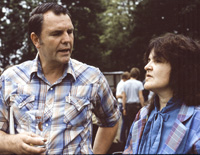
Clk to enlarge
This was a turning point, and it was one made possible by Erik Houttuin, for were it not for his initiative none of this would have come to pass. There is a tendency to think of founding a kennel in terms of identifying and acquiring the right breeding stock. But our experience was that it was not primarily a matter of acquiring the right dogs, it was a matter of identifying and establishing relationships with the right people, with established breeders and others able and willing to help, to establish a mentoring relationship. In doing so, the first lesson is that there are enormous differences in philosophy, knowledge and sincerity among the big name people and kennels, and that many are empty shell games run by people with cunning and greed, but little knowledge of or respect for the heritage, but interested in personal notoriety, position and money. Ultimately our program evolved out of the fruition of the effort and sacrifice of generations of breeders and even more directly personal relationships with breeders such as Edmee Bowles, Erik Houttuin and Caya Krisjne Locker. It truly is a community enterprise.
A few of our dogs such as Gambit were overtly social, would approach strangers and interact, but Leah was much more her own dog, stable and relaxed in diverse circumstances but not especially socially forward. Leah actually had a small acting career. In retirement she became particularly attached to our younger daughter Meredith (now Meri Winchester), and when the college theatre group put on the play Camelot[1] Meri took Leah off to audition for the role of Horrid the Dog, and she got the part. Leah adapted to coming on the stage and being appropriately animated, but staying in character without being a distraction. The one small hitch was thinking that the actor in armor might be there for a protection routine, but that quickly passed. She got a nice mention in the newspaper and voted the most popular cast member. I am not sure how widely known it was that she could be very aggressive when the circumstances indicated it.
Gambit grew up to become a big, handsome dog with an especially smooth and fluid gait and a strong but social character. He could be precocious; the conventional wisdom of the era was not to introduce the young dog to protection work until a year of age, in order to have a level of maturity and confidence. When Gambit was a year or so old we made the introduction to the protection work in the normal, for that time, way with a group of young dogs in a circle around a training helper who would challenge each dog in turn, the idea being that the general excitement would overcome inhibitions. Gambit was not supposed to get an actual bite, but the helper, with a puppy sleeve, was a bit careless and came in range. Gambit took a full, proper forearm grip and began to crush. This was a problem. The puppy or young dog sleeve was entirely inadequate and the helper was in serious pain. The other part of the problem was that the dog knew nothing about the release; the purpose of the exercise had been to build aggression and confidence. Today the dogs learn the out from the very beginning in order to create a quick release without the need for strong pressure or severe correction, thus effectively avoiding situations such as this. We eventually got Gambit to let go, but the helper was never quite the same. Gambit was always ready for the protection work, on one occasion when we were standing around talking he picked up a sleeve and slammed it into the helpers legs as a subtle reminder of what we were all there for. Gambit was NAWBA working champion twice, in Redlands, California in 1987 and in Michigan in 1989.
In the late 70s when we began our training the methods were generally very traditional, that is of the Koehler school, which was essentially carrying on the approach developed by Konrad Most in Germany and others. We did not use food or chase objects in obedience and the protection was very old school. When I saw the German Bouvier trainers Erik Houttuin had brought over for the inaugural working championships in 1980 give the dog the sleeve to carry off the field at the end of the protection routine, standard practice today, I was astonished, had never seen it done. Our original Bouviers had not shown all that much interest in retrieving balls or other objects, when I threw a Frisbee for Tory he would go out and bring it back, but after a couple of times he just took it out in the bushes and dumped it, if I wanted to be rid of it he was perfectly willing to help. Schutzhund was evolving and becoming much more stylized, whether this is a good thing is arguable, but the training was becoming much more motivational, that is, emphasizing the use of food as a reward and especially chase objects such as balls and Kongs. Coming out of KNPV lines, where the training is more demanding in terms of performance but more pragmatic in terms of style, if a dog did an automatic sit in a reasonable manner that was enough. Would seeking to breed for more retrieve or object drive be going against the grain of the Bouvier heritage, or a pragmatic adaption to changing times?
In discussing this with Caya Krisjne Locker, a Bouvier trainer and breeder in the Netherlands (also a KNPV judge), I asked her to watch for a young male with this sort of drive. Within a few months she got back to us indicating that a young male of her breeding, which had been in a home for KNPV training but experienced some unforeseen problems, was back in her possession and available. I immediately flew to the Netherlands to see the dog, Iron Xandra v Caya's Home, and bought him on the spot.
Arriving back home a few days later Iron was put in a large run to unwind, but upon walking back toward the house and looking down, there he was at heel. Apparently the wooden gate looked like a scaling wall, and Iron certainly knew what to do with a scaling wall. The next morning involved a trip to the lumber yard for some serious revisions to our kennel lay out. Iron would also go over a 5 foot fence gate, so a whole new set of agricultural style hot wires became standard for fence tops. Iron always had a strong chase drive, was particularly fond of the Frisbee, and reliably threw this in his offspring in subsequent generations. In some ways he was a stubborn and self-centered dog, would for instance more or less climb right up you if you held the Frisbee too long, and refuse to release it until he was ready. But we could send our grandchildren, very young at the time, out in the yard with the Frisbee to play with Iron, and he was perfectly gentle and patient. He was a complex and multi-faceted dog.
Although our roots had been in obedience and tracking, we quickly came to appreciate that agility, endurance and power are based on a vigorous, athletic physique, that a sound body is just as necessary as the appropriate mental and character attributes. A robust and handsome dog on the trial field was a big part of the pride in ownership. To be a good Bouvier, a dog not only needed the working requisites, it needed to look like a Bouvier. Like everyone else, early on we perceived the AKC conformation ring as the gold standard, where you went to establish and record the inherent quality and worth of your dog, that is correct and functional physique. Being a respectable breeder met buying in and supporting the AKC system, and AKC champion breeding stock was the hallmark of the respectable breeder. Little did we know.
Leah,Centauri's Fleur de Lis

Clk to enlarge -- Decoy Ron Maloney
Thus as part of the process of getting into breeding we became involved in the AKC conformation world, believing that a dog should be a complete package, that there should only be one Bouvier rather than "show" dogs and "working" dogs. Our first three Schutzhund III Bouviers – Tory, Leah and Gambit – also became AKC conformation champions of record. As mentioned, Leah had a very successful competition career, being nationally the most successful female in 1984 in the group ring.
Gambit was a big, confident, bold dog that just naturally assumed he was the rightful center of attention, a natural show dog. On one occasion the judge in an upcoming show had spoken out in one of the canine magazines about a trend to oversized Bouviers, and it was in fact true that there were a lot of ponderous, clumsy Bouviers out there, he was pretty much point on. We hesitated but then entered Gambit, and he took a four point major, which is a big deal in the show dog world. One of the other breeders questioned the judge who said that he put Gambit up because in spite of his size he was the only dog out there that could move, and it was true. Good movement was characteristic of the Bowles and Chastel programs, and a lot of it carried through. Leah, Gambit's mother, also won the group that day, we were on a roll.
But it soon became evident that the gap between show and work was inexorably widening, that ponderous, clumsy Bouviers with soft, elaborately coiffured coats were not a transient aberration, were in fact the show dogs of the future, that the same dogs could not be valid in both arenas. Early on the American Bouviers were primarily from Belgian lines, under strong Chastel influence, and also from France, where Chastel was also strongly influential. On the whole, in this era, these were still credible Bouviers in terms of character, some for instance coming from the working lines of Gerard Gelineau in France. Leah is a good example, was of Thudinie origins for generations, coming down through the Bowles line on the mother's side.
Although we dipped a toe in the water it became apparent that these lines had passed over to the dark side, were increasingly devoid of any credible pretense of trainability and useful aggression; and the gap was widening. I made the effort to train a couple of young males out of these Dutch show lines, but it was an empty experience, the mere thought of training the dog became repulsive and depressing, there was just no willingness, no drive – you looked into their eyes and there was nothing. This was a turning point, a look into the future which forced the realization that there was no future for mainstream show and pet oriented lines, and the European enforcement of bans on cropping and docking were the final nails in the coffin. Except for a small and fragile community of working breeders the Bouvier I had come to know and love was as good as gone.[2]
Thus we were at a turning point. We could see the show dog world for what it was, knew that we could play it and win. But the price was too high. The show dogs were just too insipid and boring – and so were the people – you could win, but there was really nothing of substance to win, all that was at the end of the tunnel was a pile of tin cups and a dismal, empty feeling. So we turned our back and moved on. The Bouvier world was severing and the split was inherently irreconcilable, and we had made our choice.
The Bootstraps
Gambit
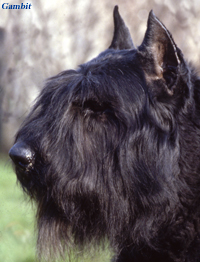
Clk to enlarge
There is an old saying in the engineering business: the problem with selecting a consultant is that by the time you know enough to make the choice you really don't need the advice. Breeding dogs is similar, is a complex process which most of us evolve into over time without a grand foundation plan, without knowing who are the valid potential mentors. Unless there is an obvious person, as in the case of carrying on an existing kennel, identifying where to go for guidance is a very difficult problem. When we were beginning there were a number of posers, breeders and kennels with shrill publicity and elaborate fabricated personas. But in reality there were three people in North America, all European born, who were relevant: Edmee Bowles and Paul DeRycke from Belgium and Erik Houttuin who was a Dutchman. We were extremely fortunate to have a relationship with Bowles in the very beginning and then a strong relationship with Erik Houttuin which carried on for many years. Although we were never close to DeRycke, he was very much Erik's mentor in terms of foundation breeding stock and guidance in the early years, when he was residing in Mississauga, Ontario near the DeRycke kennel. The other people who would play pivotal roles in our program - such as Ria Kelp, the Verheyens and Caya Krisjne Locker – were in Europe, and our relationship was established through our American mentors, most especially Erik.
The primary requisite for becoming an effective breeder is the acquisition of foundation breeding stock and ongoing additions, based on research, the knowledge and experience gained. It is elementary to read what is available, visit as many shows, working trials and kennels as possible in order to become knowledgeable. But this is in a way a superficial view, real success is more firmly based on establishing strong relationships with the right people than knowing the right dogs, especially in the early stages. Verbanck for instance played the mentor role with both Bowles and Chastel, who also had an uncle in the dog game, and is acknowledged by both of these breeders, founders themselves, in the respect they show. Over the years we were to acquire many pups and young dogs from Europe, but all of them came, directly or indirectly, from only three sources, based on a strong personal relationship, that is Ria Kelp, the Verheyens and Caya Krisjne Locker.
Another approach is the purchase of relatively expensive dogs, often important show winners, as a more direct route to the top, which is a valid approach in specific situations. Although we paid good and fair prices for our dogs, and although we once or twice contemplated an accomplished and thus much more expensive dog, we never did pull the trigger on the big purchase. For us, it was the right approach.
In June of 1984 I was fortunate enough to spend three weeks in Europe with Erik who was at the time a physician practicing and residing in the St. Louis area, an emerging presence in Bouvier affairs and a founder of the Bouvier working movement. There is simply no substitute for actually visiting the influential kennels such as Thudinie or Dafzicht, being present at a KNPV trial and particularly at club training sessions and attending the Dutch club match to personally see notable dogs such as Theo de Wagenar's Halvar Bretta v d Boevers Garden. Throughout the next decade, into the middle 1990s, I would spend a couple weeks in Europe most years, later generally staying with Caya Krisjne Locker.
[1]Located at the historic Woodstock Opera House, in Woodstock, Illinois.
[2]In very similar ways, the Dobermans, Boxers and Rottweilers were also slipping away, and although there was a much larger working community the mainstream German Shepherds, in Germany as well as America, were also passing into irrelevance. The era of the Malinois, a breed without a significant pet and show community, was upon us.
